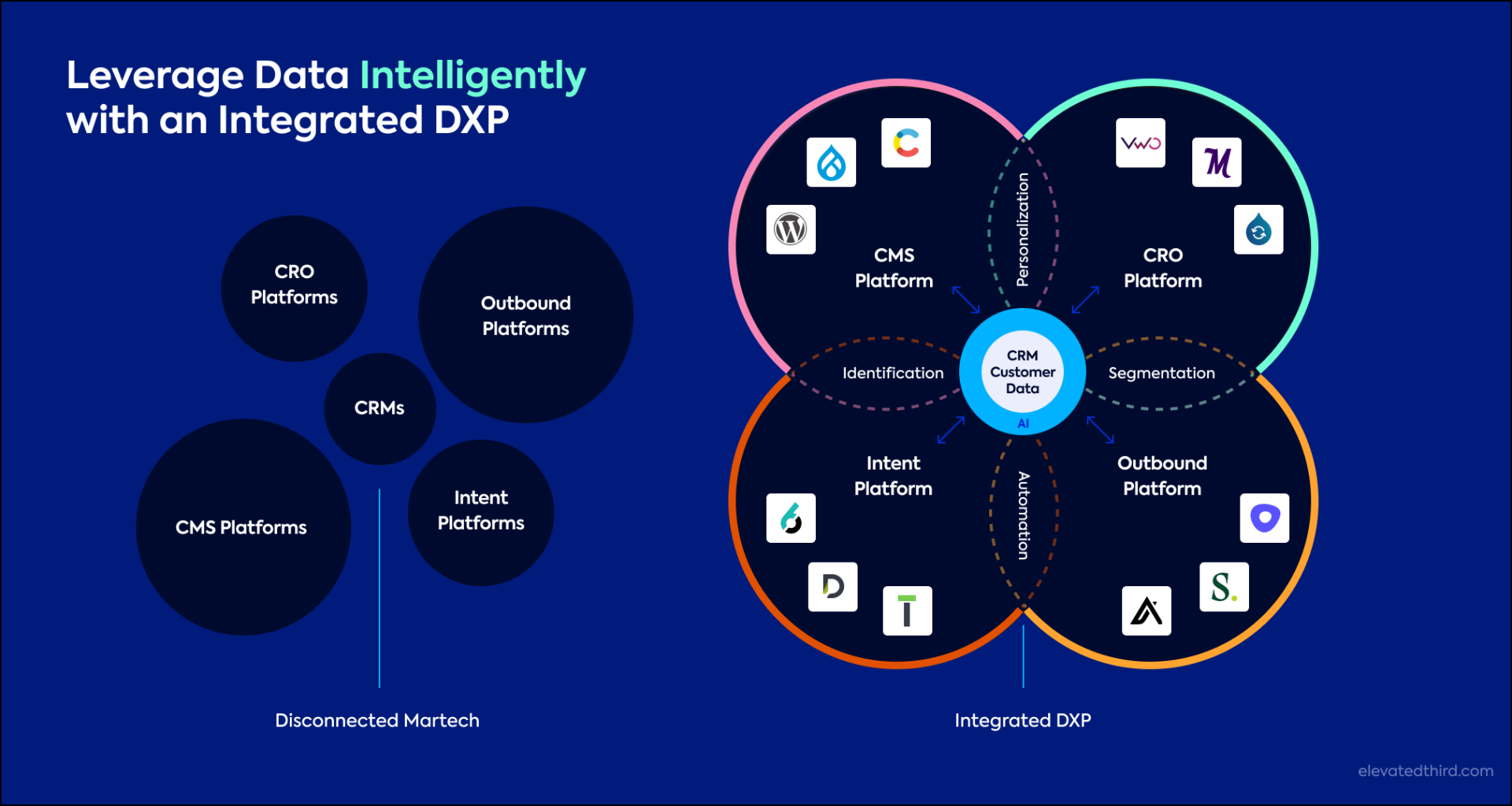Martech Agency That Connects Tech to Deliver Results
Too Many Martech Tools, Too Few Results? Let’s Connect Your B2B Ecosystem


Martech That Powers B2B Growth Through Integration
Connected Marketing Technology Leads to Revenue and Results
Disconnected marketing technology systems end with missed opportunities, wasted resources, and shallow customer insights. As a leading B2B technology marketing agency, we specialize in unifying your marketing technology stack into a connected, data-driven ecosystem. This alignment powers integrated marketing strategies, improves your website’s effectiveness, and accelerates lead generation.
Whether you're using Acquia/Drupal, 6sense, VWO, or other best-of-breed B2B marketing solutions, integration ensures everything works better together. And by leveraging intent data and AI, we help orchestrate seamless B2B customer journeys.
By 2026, Gartner estimates the number of companies with an internal mandate to adopt a composable DXP will increase to 70 percent.”
Gartner Magic Quadrant for Digital Experience Platforms (DXPs) 2024
Connecting the Journey
Breaking Down Martech Integration Barriers
Maximize the ROI of your B2B martech software investments and reduce the effort it takes to connect dots by hand.
Ecosystems unified with AI reveal useful insights and create new chances to lower costs. They help support data-driven decisions and improve your customer experience with better analytics.
By integrating ABM platforms into your stack, we enable predictive personalization across integrated campaigns. This drives higher engagement, generates qualified leads, and supports B2B marketing strategies tailored to your buyers.
Marketing Technology Consulting
Martech Integrations to Power a Thriving Ecosystem
- Conversion-Centric DXPs including Drupal, Contentful and enhanced WordPress deliver user-focused experiences that drive customer engagement.
- Advanced Marketing Automation across tools like Pardot, HubSpot, and Marketo nurtures prospects across channels and increases marketing efficiency.
- ABM and Intent Platforms like 6sense, Triblio, Terminus, and Demandbase enable precise targeting and scalable B2B engagement strategies.
- Custom data reporting platforms like Tableau, Domo, and Dreamdata help you make smarter, data-driven decisions and evolve your digital marketing strategies.
Disconnection Has a Cost—But With Us, You Don’t Have to Pay It
Disconnected martech systems slow everything down—your data stays siloed, insights stay hidden, teams lose time, and opportunities slip by. While your competitors move ahead with streamlined, insight-driven platforms, outdated tech holds your growth hostage.
That’s where we come in. We cut through complexity to help you build a connected ecosystem that actually works. Our martech consulting is not just about adding more tools. It focuses on making the tools you already have smarter, faster, and better aligned with your strategy.

Let’s move past silos and manual work.
With the right marketing services partner to connect the dots, you can improve everything from lead generation to customer engagement. Ready to see clear results and progress? It’s time to team up with a marketing technology agency that gets what’s holding you back—and knows how to fix it.
Questions & Answers
A martech consulting agency helps B2B companies improve their martech stack. They connect different platforms, align tools with business goals, and support data-driven decisions. By linking systems like CRM, ABM platforms, and analytics tools, they make your marketing more efficient and scalable.
This helps you gain better insights, level up your strategy, and improve customer engagement.
Partnering with a marketing technology agency gives B2B companies the expertise needed to streamline digital tools, improve marketing strategies, and enhance customer experience. These agencies connect fragmented data systems, enabling integrated marketing that drives lead generation and campaign performance.
A martech agency boosts customer engagement by building unified ecosystems that support integrated campaigns. Through marketing automation, intent data, and personalization, they help craft relevant, timely interactions that turn prospects into qualified leads—driving measurable results.
A full-service tech marketing agency offers end-to-end martech consulting, from strategy to implementation. By bringing together platforms like 6sense, Marketo, and Drupal, they cut down on manual work needed to connect the dots. This creates an integrated system that enables effective ABM, analytics, and content delivery. As a result, the right agency will maximize your ROI through marketing efforts.
Marketing automation plays a key role in martech stack optimization by enabling consistent, cross-channel engagement. With tools like HubSpot and Pardot, a marketing agency can automate lead nurturing. By feeding relevant data across sources into your CRM, your marketing strategies are more relevant and efficient.
Working with a martech consulting agency increases ROI by turning disconnected tools into a cohesive ecosystem. This leads to better insights, reduced tech waste, and stronger lead generation. Businesses see improved performance from existing investments and greater marketing alignment with growth goals.
Tech marketing agencies use platforms like Tableau and Dreamdata to centralize and analyze customer data. These insights drive personalization and inform integrated campaigns, resulting in improved customer experience, higher engagement, and more qualified leads throughout the buyer’s journey.
We can build a better ecosystem, let us show you how.

